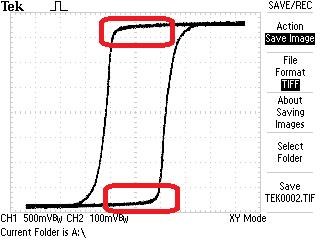Chris
posted this
28 February 2020
- Last edited 28 February 2020
Hey Guys,
@YoElMiCrO - Is this your theory? Do we understand this correctly?
The BH Curve, or the Hysteresis Curve is typically an Alternating Current Concept, the Magnetic Field pushes through a full cycle. We know the Magnetic Field is Current I through N Turns, which is M.M.F. There are Losses just in the BH Curve without loading the Transformer.
Of course, if the BH Curve is Non-Linear. B is Flux in Gauss, and H is Strength, so this Graph is Density vs Strength:

The Knee of the BH Curve, marked as b and e, is where we see the most Non-Linearity, but what is Non Linear? The Inductance of the Coil is lost at saturation, so this point is where the Coil is moving into Non Inductive and Inductive again. This is a material Effect, the Core itself is moving in and out of saturation at the knee, which is marked as b and e.

Some time ago, I published a document: What's it going to take to get OU? in that paper I gave some examples of this Inductance change and what it would mean achieving the Energy Gain. I looked at this from the point of Energy Stored in an inductor: 0.5 LI2
Looking back, I got my math wrong, squaring the Inductance, not the Current. However, a simple review:
We get: 0.5 x 2 x 32 = 9.
We get: 0.5 x 7 x 32 = 31.5.
The truth of the matter is, I does not stay constant, as L changes, I is forced to change also. So my math is not valid and does not take into account these changes. Of course, the definition of Inductance defines how Current travels through an Inductor. So more work is required in this area.
To make the Inductance change, then the Knee is where one should work:

One Coil getting you up to the "Turnaround Point", where a normal transformer is at maximum Magnetising force, and the other Coil pushing up over the knee and back again. Of Course this down hill is where one may see an energy gain.
@YoElMiCrO - Is this your theory?
Just so we are clear, my work is different from this, although there must be an opposition, I believe from Core to Output Coil is the mechanism. Energy must come from a Source, it cant just appear from fresh air. So a Pumping of sorts must occur.
Thank You Guys for sharing your work! I think there is a great deal that can be learned here. If we can all get on the same path here, then big steps forward could be made!
Best wishes,
Chris

























































---open-tesla-research.jpg?width=20&crop=0,0,20,20)



